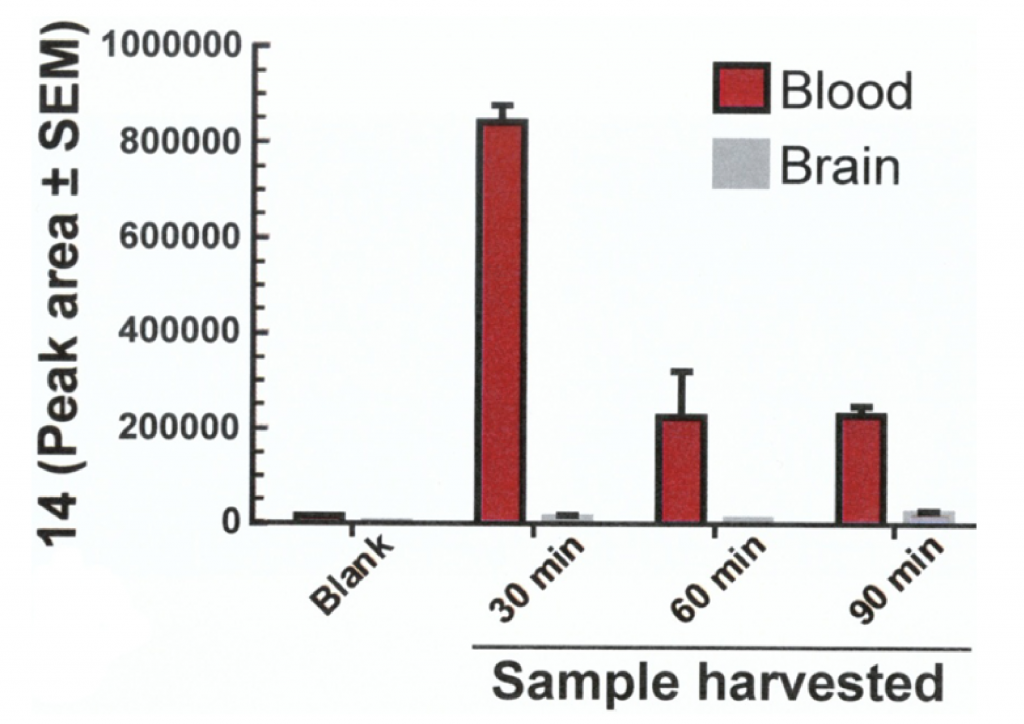Diimidazodiazepine 14
Parallel Synthesis of Hexahydrodiimidazodiazepines Heterocyclic Peptidomimetics and Their in Vitro and in Vivo Activities at μ (MOR), δ (DOR), and κ (KOR) Opioid Receptors (25)
Introduction: This paper investigates the antinociceptive activity of a compound, diimidazodiazepine 14. Antinociception is the ability for the
compound to suppress pain by inhibiting signals to sensory neurons. Diimidazodiazepine 14, a heterocyclic peptide, was modified from reduced dipeptides to peripherally bind to κ opioid receptors (KOR) and produce opioid analgesia without adverse side effects.

Background: Morphine, one widely used opioid for treating pain, is selective for centrally located µ opioid receptors (MOR). However, this form of analgesia is associated with side effects such as addiction, respiratory depression, and constipation. Other opioid receptors, namely κ and δ, also produce side effects such as seizures, aversion, and psycho-mimetic effects in the central nervous system (CNS) when targeted by their own selective agonists. Side effects arise due to central selectivity to the receptors and easy penetration through the blood brain barrier (BBB). Analgesia, however, is achieved by both central and peripheral targeting. Since peptides poorly cross the BBB and do not penetrate the CNS, diimidazodiazepine 14 was modified to be peripherally selective to KOR to achieve opioid analgesia with no side effects.
Evaluation and assessment assays: Peripheral selectivity of diimidazodiazepine 14 was calculated after IP testing in a mouse withdrawal assay. Oral absorbance together with CNS penetration were confirmed by collecting profused brains from mice and using LC-MS detection to analyze BBB penetration by the peptide after oral administration.

Figure 31. Eans et al., 2019 showing LC-MS/MS detection of diimidazodiazepine 14 in blood and perfused mouse brain after administration. It confirms impermeability through the BBB.
Conclusions: By selectively targeting peripheral κ opioid receptors, the heterocyclic peptide, demonstrates antinociceptive activity without CNS penetration. Even though it is slightly less effective than morphine, it provides pain relief without euphoria and adverse side effects.
November 9, 2019 at 11:35 pm
This looks good, but I’m curious how the withdrawal assay worked? what were the scientists specifically looking for that indicated withdrawal?
December 13, 2019 at 9:27 pm
For the withdrawal assay they were basically looking at suppression to pain via the potency of the compound. They placed the tails of the mice on hot plates and observed how long it took for them to ‘withdraw’ their tail from the heat.
November 10, 2019 at 6:08 pm
Make sure to stay consistent with writing the Greek letters in English or keeping the symbols.
November 10, 2019 at 6:10 pm
As well, your introduction paragraph can be rewritten better without repeating diimidazodiazepine 14 so many times. This can make the reader overwhelmed.
November 10, 2019 at 9:26 pm
I think that this paper and the results shown are very interesting and it was clear and concise. I did notice however that one of your questions was about the advantages of short peptides in your question page. In your answer page you briefly reference this study but I think that maybe the result of this experiment should be talked about more since I think it answers one of the questions that you ask in the question page.
December 13, 2019 at 9:44 pm
We did mention the result from this experiment citing that due to peripheral selectivity of peptides , they are excellent candidates to alleviate pain without side effects.